|
These challenging times can be both stimulating and stifling to creative types. Some writers and artists I know have found comfort in their work; others have been unable to summon their muses and have turned to other activities for solace. I say, whatever works! These times are exceptional, and as I recently read in an article a friend sent me, “During this extraordinary time, we have to realize that everyone now has an additional part-time job that might be called Citizen of the Covid-19 Pandemic,” and we need to give ourselves credit for the time and energy that extra work takes.  Gail Howarth Gail Howarth One artist who's managed to do inspired and inspiring creative work while coping with the pandemic is photographer Gail Howarth. Regular readers of HeartWood may remember seeing Gail featured here a couple of years ago. At that time, she was working on a photography/writing project with Mel Trotter Ministries, a Grand Rapids nonprofit organization that works with homeless people. Now, she is once again combining photography and writing to call attention to today's pressing issues, which include but are not limited to COVID-19, essential workers, race and racism, and LGBTQIA community concerns. What led you to undertake this project? City Center Arts in Muskegon offered me the opportunity to be the featured artist there from September 1 to October 10. The gallery has been very supportive of me, my nature and landscape photography, as well as another project I am working on called The Gratitude Project By Lakehouse Photo. Originally we were going to feature The Gratitude Project. However, the rest of the exhibit will honor essential workers. We felt that gratitude, while a worthy topic, might seem insensitive to those that have sacrificed so much. We thought about postponing the featured artist wall or displaying my landscapes. But I felt like we were missing the opportunity to do something meaningful. The year 2020 has been challenging. The pandemic, racial tension and rioting, and a divide that grows deeper daily in our nation weigh heavily on my heart. I just kept thinking, this is a time to heal, not to fight amongst one another. When I proposed A Time To Heal to the folks at City Center Arts, they quickly agreed to the project. Christina once asked herself, Am I Black Enough? Later in life, as she experienced racism in many forms, the answer became clear. Christina expresses her concerns, her anger, and her wisdom by blogging and through dance. How did you find people to participate? Were most readily willing, or did you have to persuade some? I asked everyone I knew if they would participate, and then they asked everyone they knew. I posted requests for participants on my Facebook and Instagram pages and even contacted local social justice organizations. Most of the participants were referred through the gallery or Facebook friends. Of the 17 participants, I knew less than one-third personally. I received a lot of non-responses to emails and phone calls. However, those that expressed an interest in the project showed no hesitation about participating. Everyone felt like it was an important project and wanted to be involved. Like so many others 2020 grads, Chauncey lost the opportunity to complete his senior year of high school in person and to experience senior prom, skip-day, an actual graduation ceremony, and more. Read more about Chauncey here. How do you think communicating these varied stories and images can promote healing, both for individuals and for our country and world? In a nutshell, we need to get to know one another. The project gives folks from various backgrounds the opportunity to share their journey with people that are generally not a part of their community. Once we find common ground, it will become easier to communicate about and resolve tough issues. One example from the project would be that there has been immeasurable conflict related to wearing a mask to keep COVID-19 from spreading. There are many reasons stated, but I believe the biggest factor is that folks don’t know anyone that has had it, and therefore, it does not seem real. Three of the participants of the project have had COVID-19. Though all three have recovered, they struggle with ongoing health issues. One person caught the virus from a man that did not survive. Another worked in one of the hardest-hit hospitals in the Detroit area. She witnessed countless deaths every day. All three encourage everyone to wear a mask. Once you know someone that has had the virus, you will likely not question whether mask-wearing is right or wrong. Healing begins one person at a time. Hopefully, healing begins with one person, then a second and a third, and multiplies and impacts a whole community, a state, a nation, and beyond. Healing can be hard work and take years. But it can also be quite magical. Have you ever had a rigid belief about a thing and then learn one new fact about it, and it shreds everything you ever believed? I do hope that folks will find a few magical moments from the exhibit and blog posts. I don’t believe my project alone can make a profound change in the world. I do think that projects with the same or similar intentions are popping up all over as a reaction to the dysfunction we are currently experiencing. I hope that collectively change can and will happen. Lastly, I will admit that there was a moment during the early part of the project that I became disillusioned. Not all of my friends or family felt the project had merit. They thought that the result might create greater divisiveness versus the desired outcome of healing. I shared with one of the participants that my heart was a bit broken by the response. I asked her earnestly, what if the only heart opened or healed was my own. Her response was: Well, then the whole project is worth it. I am grateful, and I cherish her words. Working as a respiratory therapist at one of the hospitals hardest hit during the early days of the COVID-19 pandemic, Cindy contracted COVID-19. Now recovering, she asks that everyone wear a mask. In the introduction to “A Time to Heal” on your blog, you write about parallels between the present day and the 1960s. What similarities and differences do you see between the two times? Now and then, social unrest led to demonstrations and rioting. In the ’60s, the issues were related to civil rights, the feminist movement, the Viet Nam War, and the gay liberation movement. Today, we face the same problems and more, but the war we are fighting is with one another. Also, in the ’60s, people still had faith in our government, that our voices would be heard, and that real change could happen. Today, we have lost faith in leadership and our government, that our voices, no matter how loudly we cry, fall on deaf ears, and there is little hope for change. Kwame uses his sense of humor and insight to elevate awareness related to racism and the Black Lives Matter Movement. Kwame believes we are fundamentally bound together and that together we must find a way to get along. In your interviews with this broad spectrum of people, have any common themes emerged? The commonality would be the need or desire of the participant to tell their story or to be heard. All felt that in doing so that it might, in some small way, make a difference. Susan Bishop, MD, is a pediatric doctor. As COVID-19 has significantly changed patient care, she misses children's hugs and unmasked smiles. In an email, you wrote, “The creative process is funny for me. I never have a clear picture of what something will be in the beginning. It just morphs into what it becomes.” In what ways was that true for this project? First, I had no idea if I could pull off this project. I had two months during a pandemic to find people willing to be photographed, to share their stories, and translate them into an exhibit of words and images. Initially, I thought I would display one photograph and a few keywords of each person to convey the story. However, I could not come up with a smart way to show the words. In the end, I decided to label the images more traditionally. Each piece has a name and just a little information about the participant. Hopefully, viewers will become curious enough to read more about the participants on my blog. Then, as I selected and edited photos, I realized that for most participants, a single image left the story incomplete. I began mounting three to five images into a template with a plain white background. The stories were coming together, but still, something was lacking. One day, I accidentally placed one of the photos behind the others. It was fabulous!! I reduced the grayscale of the background image (made it lighter), and it became part of the story. In some cases, I had to backtrack to find and photograph backdrops that would complete the story. Lastly, I initially had a narrow concept of who should participate. The expansion happened naturally and felt right. When Justin learned personal protection equipment was in short supply, he came up with a plan that included renting the second largest cargo plane in the world and having it flown to China, filled with supplies, and flown back to Ohio to begin distribution. He then purchased US-made mask-making equipment and started production in Ohio. How has this project affected you personally? Deeply and on so many levels. There were many days that I felt hopeless. The division between people feels as if it grows larger every day, and I did not feel as though I was working fast enough or hard enough. But I came to believe that I am doing what I can to be a positive force for awareness and change. I will, in some way, continue the work that has begun with this project. I am honored and humbled that complete strangers would take the time to share their life experiences with me. Their words forever change me. The most life-changing aspect of the project is related to racism. I have never considered myself a racist. But, I have become more aware of the cultural bias that I carry with me. I listen with new eyes and ears, and feel with a heart more open. And, as those old untruths pop up, I look them over and toss them away. We have so very much to learn from one another. I am a forever student, and can barely wait for my next teacher. Siena is working toward awareness and social change as a member of the Sunrise Movement, an organization that seeks to remove oppressive and unsustainable systems to create a just future. What is your hope for this project and its impact? I hope that hearts and minds will be changed, that we will become a more unified people, even if we disagree, and as a result, create a better future for our children. That is a pretty big hope, isn’t it! I am not sure if it is realistic at all. But, in the words of John Lennon, “You may say I'm a dreamer, but I am not the only one.” I hope others will be inspired to start projects that promote healing and unity. Pastor Sarah believes it is time to put an end to our differences based upon race, learn to imitate the Kingdom of Heaven, and to live as one. Read more about Pastor Sarah here. A Time To Heal will be on display at City Center Arts from September 1, 2020, until October 10, 2020. Hours are limited, so please check the website before traveling to the gallery. Blog posts related to the participants are located at https://lakehousecc.com/living-at-the-lakehouse/
Not all blog posts related to the project are complete. Consider subscribing to be notified of new posts.
7 Comments
The last installment of HeartWood—the story of a young writer’s devotion to his grandmother and her literary legacy—got me thinking about other stories of art and devotion, which took me back to a trip to Albuquerque three years ago. 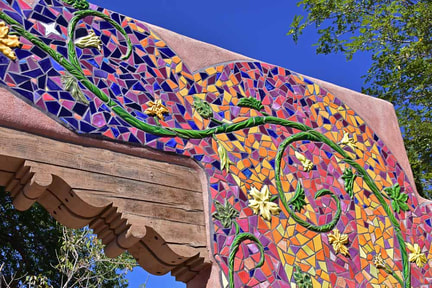 Mosaic in Albuquerque's Old Town Mosaic in Albuquerque's Old Town Albuquerque, nearby Santa Fe, and their surroundings are spilling over with creative people whose devotion to their art is evident. Painters, sculptors, mosaic artists, multi-media creators, jewelry designers—they're everywhere, and so are the fruits of their talents.  Promoting the Santero Market Promoting the Santero Market Evident, too, are signs of a different kind of devotion: works of art inspired by spirituality and religious faith. I learned about one type of this art from two women I chanced to meet on a Sunday morning in Albuquerque's Old Town. Felis Armijo and Ramona Garcia-Lovato were sitting at a table in front of San Felipe de Neri Church, signing up volunteers to help with the upcoming Santero Market. Santeros (and santeras) are artisans who craft religious icons called santos. Originally created for churches, these statuettes of saints, angels, Mary and Jesus, usually carved from wood and often decorated with home-made pigments, are now sold to tourists. 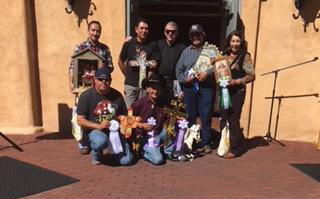 My conversation with Felis and Ramona rambled from topic to topic, touching not only on art, but also on writing, life stories, geography, and human nature. From their curiosity and warmth, it was clear these two women were dedicated not just to the event they were promoting and the parish to which they belonged, but also to connecting with other people—an art in itself. 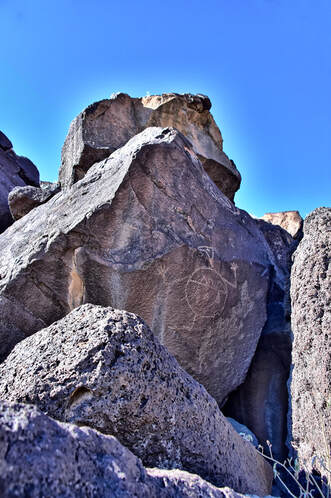 Petroglyph Petroglyph After our time in Old Town, Ray and I ventured out to Petroglyph National Monument, a short drive away. One of the largest petroglyph sites in North America, the monument features designs and symbols carved onto the surfaces of volcanic rocks by indigenous people and Spanish settlers 400 to 700 years ago. The site and its images still hold spiritual significance for the descendants of both groups of people.  Significant symbols Significant symbols The meanings of some symbols have been lost over the centuries; others are known by a few indigenous groups, but it is considered culturally insensitive to reveal the meaning of an image to others. For me, it's enough to know that the symbols meant something to the people who created them and to ponder the combination of location and inspiration that gave rise to their work.  Larry Schulte Larry Schulte Not all works of devotion have religious significance. They also can be inspired by a more secular kind of admiration. Case in point: my friend Larry Schulte, an artist who now lives in Albuquerque, created his own "Saints" series, featuring mortals who have made a difference in his life. “I was raised in a fairly strict Roman Catholic home, and I left that faith many years ago—mostly because of their stance on gay people, that we were sinful,” Larry reflects. “These saints in some way replace the saints I learned about in my childhood . . . They are all loving, sharing people who have made my world a better place. We all need something to believe in. For me it is love, art/creating, and people, rather than any organized religion.”  St. Lou St. Lou Some of the fifteen mixed media pieces, which Larry created at the Ragdale Foundation, an artist's colony north of Chicago, feature well-known figures—such as the innovative composer Lou Harrison and Harrison's life partner Bill Colvig, an instrument builder who collaborated with Harrison on gamelans and other percussion instruments. But they also include more personal choices: Larry’s undergraduate art instructors, St. Jack and St. Keith, for instance. “Jack was particularly influential in my pursuing art,” Larry recalls.  St. Elvira St. Elvira St. Elvira’s son Peter was Larry’s roommate and best friend during their days at the University of Kansas in the late 1970s to early 1980s. Elvira lived in New Jersey but had visited Peter and Larry in Kansas. “After I moved to New York City, she included me in holiday family gatherings when I wasn't able to get back to my own family in Nebraska. She adopted me as another son.”  St. Bill St. Bill In 2016, Larry and his partner Alan Zimmerman, a percussionist, traveled to San Francisco for a concert of Harrison's music to celebrate what would have been his 100th birthday. Two of Larry's art works (St. Lou and St. Bill) were exhibited at the concert, which was sponsored by the non-profit organization Other Minds.
If you've been a HeartWood subscriber for a while, you may remember the Last Wednesday Wisdom feature that appeared on the last Wednesday of every month. When I switched to publishing blog posts only twice a month--on the first and third Wednesdays--that feature went away, except for occasional appearances in months with an extra Wednesday. During these troubled times, though, I couldn't think of anything better to offer than a collection of wisdom from other minds. I hope you find comfort and inspiration here. Life is glorious, but life is also wretched. It is both. Appreciating the gloriousness inspires us, encourages us, cheers us up, gives us a bigger perspective, energizes us. We feel connected. But if that's all that's happening, we get arrogant and start to look down on others . . . On the other hand, wretchedness--life's painful aspect--softens us up considerably. . . but if we were only wretched . . . we'd be so depressed, discouraged, and hopeless that we wouldn't have enough energy to eat an apple. Gloriousness and wretchedness need each other. One inspires us, the other softens us. They go together. -- Pema Chödrön You only get one chance. You have one journey through life; you cannot repeat even one moment or retrace one footstep. It seems that we are meant to inhabit and live everything that comes toward us. -- John O'Donohue Prejudice of any kind implies that you are identified with the thinking mind. It means you don't see the other human being anymore, but only your own concept of that human being. To reduce the aliveness of another human being is already a form of violence. -- Eckhart Tolle When you can't find someone to follow, you have to find a way to lead by example. -- Roxane Gay Clouds come floating into my life, no longer to carry rain or usher storm, but to add color to my sunset sky. -- Rabindranath Tagore My sense of the holy . . . is bound up with the hope that someday, any millennium now, my remote descendants will live in a global civilization in which love is pretty much the only law. -- Richard Rorty We have to fight them daily, like fleas, those many small worries about the morrow, for they sap our energies. -- Etty Hillesum You may not control all the events that happen to you, but you can decide not to be reduced by them. -- Maya Angelou You say to yourself when you are at liberty how desperate you are for your solitude, you love your periods of solitude, you scramble for it, you find ways of being by yourself so you can do what you want with yourself and your mind. But when you're deprived of it for a lengthy period then you value human companionship.
-- Wole Soyinka Even in this strange and uncertain time, we can find reasons to celebrate. Two big reasons come to mind this month.  April is National Poetry Month, and if ever there was a time to read poetry, it’s now, when many of us have extra reading time and are looking to fill our minds with something other than dire news reports.  This month also brings the 50th anniversary of the first Earth Day next Wednesday, April 22. Though the mass celebrations that had been planned will no longer be possible, we can still commemorate the day. Combining these two celebrations, National Poetry Month and Earth Day, I asked local (and not-so-local) poets to contribute Earth Day poems to today’s blog. I’m happy to share those with you now, along with the collage I created for the occasion. As I worked on the collage, I went back and forth in my mind about whether to portray the vision of a healthy Earth that many of us had on the first Earth Day in 1970 or the reality of Earth in 2020. In the end, I opted for the more hopeful vision, because I want to believe there's still hope. Once the piece was done, however, I noticed it's darker than most of my other collages (many of which are now posted on the COLLAGES page on my website). Perhaps in the end, my Earth Day collage reflects both hope and concern, themes you'll find in the poems below. And now, poetry. Sunset Off Brockway |
| This silent green life and death place. Life bursts forth, buzzing around me. Death underfoot- covering the forest floor. Smelling of earthy must and sweet pine. Fallen trees, once promising, now slowly decaying back into Life-giving soil. Life and Death- existing in this shared space. Life and Death, working hand in hand. Life giving into Death giving into Life. |
I Think They Will Not Mind
by Marsha Reeves
I think they will not mind that
wiikaa bi-dagoshinaan.
I arrive late.
Gijiigijigaaneshiiyag gii-giimoodaanagidoowag noopiming
The chickadees were mumbling in the bushes
besho naadazina’iganing.
by the box where I get mail.
Andawendaanaawaa Manaadendamaazowin
They needed an Honor Song
mii wenji-nagamotawagwaa
so I sang to them
nisidawenmangwaa miinawaa
because we understand them again
ezhi-manaadenimangwaa ingiw wiidokawiyangidwaa
the way we respect those who keep us company
gabe biboon
all winter.
Gaawiin da-giizhokoniyesiiwag misawa
They do not need to dress warm and yet
giizhokawiyangidwaa gidode’iminaaning.
they warm our hearts.
* First published on ojibwe.net
Written on the Wind
by Tom Cordle
I stumble in this foreign tongue and try to make the talk
I speak of when this land was young, and of my brother hawk
My spirit voice is hard to hear, I have so long been gone
But I will whisper in your ear, and having spoke, move on
This finger pushed into the sea of sand and swamp and pine
Has been a welcome home to me – I sing this land of mine . .. .
Of night song sung in joyous trill by every kind of fowl . . .
Of chickadee and whippoorwill . . . of warning from the owl . . .
Of plenty fish and wild oats . . . of berries blue and red
That danced their way down happy throats to bellies always fed . . .
Of rivers coursing through green world of gleaming golden lake . . .
Of alligator, hog and squirrel . . . of moccasin the snake . . .
The screaming panther ruled the pine, the eagle ruled the sky –
Oh, will you hear these words of mine? Will you even try?
I have no words on talking leaves for you to read, my friend
For all this simple man believed was written on the wind.
Animal Planet
by Tim Hawkins
and our hearts seek meaning among the stars,
wild creatures assert their presence
in the here and now
and the just here and gone.
Unknowable in the way one speaks
of the alien and other-worldly,
the title to their kingdom is forged
in their absolute
manifestation of the flesh.
If this seems ironic and abstract,
then so be it.
For irony and abstraction
are our great gifts--
not to the world, but to ourselves--
invented for our survival.
And we, of course, are the real aliens;
Each a world unto one’s own,
orbiting a sun of its own devising.
* First published in Sixfold, July 1, 2013, Summer 2013
Collected in Jeremiad Johnson (In Case of Emergency Press, 2019)
Our Mother (In the Pandemic of 2020)
by Sally C. Kane
Do you hear her – Our Great Mother?
In this moment, in time - a reprieve -
when all human activity
has slowed to bare bones minimum,
She inhales an expanse of cleaner air.
Exhales a wasteland of toxins.
Do you hear her – Our Great Mother?
She weeps for us, her children – All
Residents, two-legged and four,
winged, finned and serpentine. We
share the same earth, sea and air.
We, the two-legged ones, hold
the choices in concert with Our Mother.
Even as forces seem out of control, and
the playing field remains unequal.
Do you feel her – Our Great Mother?
She shudders as the sludge venoms
from Frack wells, the vast desolation
from wildfires, and endless wars’ ravages
do a rival dance with the C-virus.
I wonder about this massive
Blue Marble in our universe. The
one we call home. Our Mother.
There’s nowhere else to go. We cannot
just walk off or fly away.
I wonder, if I were an astronaut, or
could hitch a satellite ride, how - in this
Pandemic blink of time –would
Our Mother, our home - look?
Would her greens be greener, her blues
be bluer, her storms less turbulent,
her mass free from veils of smog?
Like a cataclysm, would I see
a rotating orb, vibrating
glimmers of brighter, kinder energy?
Perhaps violet or white? Would
I know – would we all know- we’ve
begun to exercise our choices for love?
Mother's Milk
by Jessica Mondello
Addiction lies between the lines
And love was lost to pride and glory
This ego virus made us blind
Your mother's dying by your hands
But you won't listen
Her blood is all over your hands
Will you listen
The soul was lost beyond the shadows
The fog will choke us into dust
Collective conscience chose the gallows
The time of man will turn the dust
Your mother's dying by your hands
You won't listen
Her blood is all over your hands
Will you listen
The Soul of Spring
by Kathy Misak
I see it in the buds of the maple.
I hear it in the sounds of the red wing black bird.
Inquisitive cat so happy to be playing outside
Warm breeze on the back of my neck
I see it in the new bright yellow feathers of the gold finch.
I hear it in a distant barking dog.
Ever grateful to be walking this Earth mother experiencing my spring soul
And The Earth Stayed Young
by Tom Cordle
And the buffalo could roam
The rivers clear and clean
Washed by our simple homes
And all turned in the wheel
And the sacred song was sung
To teach us what was real
And the earth stayed young
Once a man would take
No more than he could use
Set bones back in the lake
When a meal of fish was through
And all turned in the wheel
And the sacred song was sung
To teach us what was real
And the earth stayed young
Once the earth was young
And men saw with their hearts
That everything was one
And man was but a part
And all turned in the wheel
And the sacred song was sung
To teach us what was real
And the earth stayed young
Now the earth is old
The buffalo are gone
The rivers have been sold
And man stands all alone
Let all turn in the wheel
And sing the sacred song
To teach us what is real
So the earth stays young
What Have You Learned
by Jessica Mondello
That you've all been praying on
That God has only destroyed you
And you can't drink the oil
You've been pulling out of the ground
Your momma's shaken and torn . . . fool
Do you know what you are
And what you're here for
When it all comes crashing down
What have we learned
Distractions have kept you
From what's really going on
Keeping you away from your mother
Her life source you could tap into
Can heal that broken bond
Yes, you can get there inside you
Do you know what you are
And what you're here for
When it comes crashing all down
What have we learned
Pale Blue Seasons
by Tim Hawkins
in the flight of a heron, and to the surrounding
darkness where countless feed.
But so much that is unattainable, so much
that lies beyond the sovereign dark, rises up
out of the pale blue season of twilight
like fireflies summoning among the trees
as the moon loses her translucent and ghostly pallor
in the evening’s first clear and troubling dreams.
***
Toward daylight, the deer rise up
from among the flattened grasses
and low-lying hummocks,
emerging in the cool of morning
from indiscernible swales
and cedar swamps,
wary and shy, but alive with owning
at least a part of this
pale blue season of wildflowers.
* First published in Blueline: June 2011, Volume 32
Collected in Wanderings at Deadline (Aldrich Press, 2012)
Life can be like that, too. With so much going on in the real and virtual worlds, not to mention our own imaginations, it's sometimes hard to narrow our focus. Yet often that's exactly what we need to do to feel calm and grounded and to nurture our creativity.
I recently came across an intriguing exercise that reminded me of the benefits of concentrating on one thing at a time. In her Writing and Wellness newsletter, author Colleen M. Story wrote about boosting creativity with color walks. You pick a color before heading out on a walk and then let that color lead you as you search for objects of that hue.
Colleen's article goes into more detail, with tips on how to get the most from the practice.
I'll let you read that on your own, because I'm eager to show you what I found on my color walk. On the summer day I chose for my walk, everything was green, so as a challenge to my powers of observation, I picked yellow. I was surprised how many yellow things I found and how paying attention to them helped me see my familiar environment in a whole new way.
I hope you'll try a color walk, too, and tell me how it goes.
So here you go . . .
-- Mark Coleman, Mindful magazine, April 2019
-- Edward Abbey, "The First Morning," Desert Solitaire: A Season in the Wilderness
-- Brother Blaise Heuke, "The Beauty of a Bee," AARP The Magazine,
-- Dave Eggers, The New York Times, June 29, 2018
James Gleick, Authors Guild Bulletin, Spring-Summer 2018
-- Lenore Myka, "When to ignore good advice," Poets & Writers magazine, Sept/Oct 2018
-- Kathryn Budig, Yoga Journal, August 2018
 Wander Women on the trail
Wander Women on the trail For a few years now, I have closed out most weeks by taking to the trails with the Wander Women, a local hiking group. We walk, and we talk, and we take in the sights and sounds along our woodland paths. But the truth is, we don’t really wander. We have a definite destination and an approximate time frame, from which we rarely deviate.
 A woodland trail invites aimless idling
A woodland trail invites aimless idling Sometimes, though, when I’m on my own in the woods—or on a city street, for that matter—I like to just aimlessly meander. That makes me a flâneur, a word I learned from a lovely article in Mindful magazine. The word has been variously defined as “an aimless idler” and “a passionate wanderer.”
 My Detroit ramblings sometimes took me to the Ren Cen
My Detroit ramblings sometimes took me to the Ren Cen Later, when I worked in Ann Arbor, my lunchtime walks took me into various neighborhoods, where I found inspiration in the creatively-designed gardens, quirky houses, and funky yard art I passed along the way.
 A just-bloomed wildflower might catch my attention when I wander with no particular purpose in mind
A just-bloomed wildflower might catch my attention when I wander with no particular purpose in mind That’s exactly what I find myself doing on my walks these days. A just-bloomed wildflower, an oddly-shaped stone, a leaf floating down the creek—there’s no telling what will catch my attention and take it far from whatever minutia occupied my overloaded brain before I set out on my stroll.
 Mental meanderers have creative brains
Mental meanderers have creative brains Whether you ramble solo or with fellow flâneurs, you can bet your creativity will get the same kind of boost, as long as you let your mind meander freely. Researchers at Georgia Institute of Technology found that frequent daydreamers scored higher on tests of intellectual and creative ability and used their brains more efficiently (as measured with brain scans) than people who zoned out less.
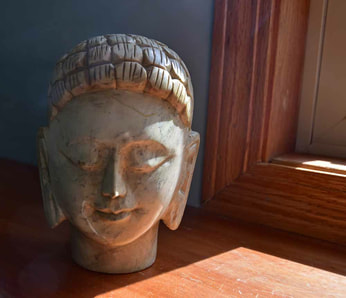 A sunny windowsill at Fae Wood Studio
A sunny windowsill at Fae Wood Studio In some ways, the third Monday in March seemed like any other Monday. Early that morning, eleven of us trooped into Fae Wood Studio, the serene space that’s been our yoga home for the past couple of years. Just as she had on so many other Mondays, our teacher, Behnje Masson, led us through a series of moves that refreshed our bodies and boosted our spirits.

As I've written about before, yoga with Ellie, followed by breakfast at Hit the Road Joe Coffee Café became a can’t-miss Monday-morning routine for the group (which I joined about seven years ago), and friendships flourished in the process.
 The peaceful setting of Fae Wood Studio seemed magical at times
The peaceful setting of Fae Wood Studio seemed magical at times When Ellie died unexpectedly in 2016, we were adrift. Yet we kept our Monday morning yoga-and-breakfast sessions going, even when we had to squeeze into someone’s living room or loft to practice together. Then, through a charmed confluence of events, Ellie’s sister Kathy invited us to use her newly-established studio, Fae Wood, and Behnje offered to drive up from Grand Rapids twice a month to teach us. It was an ideal arrangement, one we’ve been privileged to enjoy for almost two years.
 Ellie's favorite Ganesh figure
Ellie's favorite Ganesh figure 

 The ever-crafty Val
The ever-crafty Val Except for one. More a card-sized parcel than an ordinary envelope, it intrigued me with its cobbled-together lumpiness. When I noticed it was from my uber-creative friend Val in North Carolina, I couldn’t resist opening it right away.
In an earlier email exchange, Val had told me about her latest obsession: making “junk journals” and altered books from bits of this and that. I had no idea that junk journaling is a thing, but it is. Val confessed she’d gotten wrapped up in YouTube videos showing how to make the whimsical little assemblages.
More on those videos in a moment, but back to that mysterious envelope.
 The front cover of the junk journal my friend Val made for my birthday
The front cover of the junk journal my friend Val made for my birthday  Once you venture into junk journaling, you may find yourself desperately needing things you never even knew existed, like this corner-rounding punch
Once you venture into junk journaling, you may find yourself desperately needing things you never even knew existed, like this corner-rounding punch A junk journal is really whatever you want it to be, but it usually includes some combination of words, pictures, and other memorabilia, such as brochures, ticket stubs, maps, calendars, cards, or whatever else you want to include, all assembled in a helter-skelter way. The idea appealed to my passion for making collages and my tendency to hoard paper memorabilia with which I have no idea what to do.
But before I plunged in, I felt like I needed at least a little guidance. That’s how I found myself in the online realm of junk journal inspiration. It soon became clear that, like scrapbooking, junk journaling is one of those hobbies people can go a bit overboard on. I found photos of amazingly—and intimidatingly—elaborate journals, along with lists of all sorts of paraphernalia one might want to purchase, either to decorate the journal (where’s the “junk” in that??) or to use in crafting the journal: pre-made pockets, special paper cutters, fancy papers, bookbinding twine.
 I used Val's design as a model, copying her open-ended manila envelope cover
I used Val's design as a model, copying her open-ended manila envelope cover I could see hours, if not days, swirling down the drain. So I set limits. I would watch only enough to learn a couple of things: How to make origami envelopes and library card-style pockets. Then I’d figure out the rest by studying Val’s example and just winging it. This decision also helped with the intimidation factor. Junk journals are supposed to be messy, but some people’s messy still comes out looking a lot more artful than mine. The sooner I stopped looking at videos and started doing my own work, the happier I’d be.
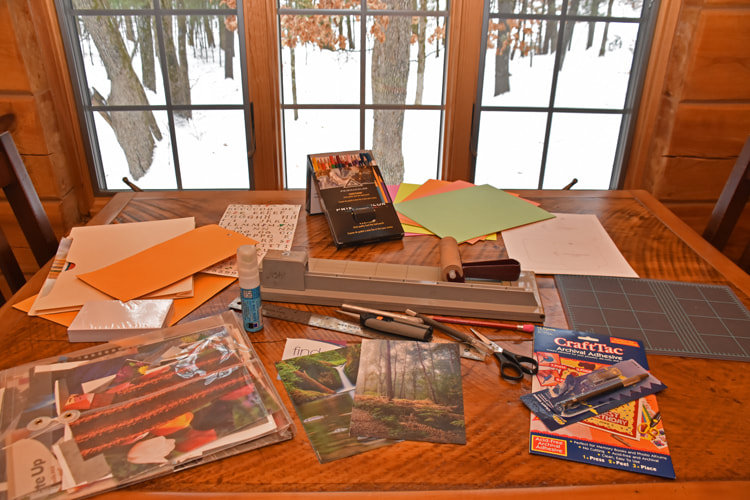 On a snowy afternoon, I gathered up paper, glue, scissors, magazine clippings, and other supplies to make my first junk journal
On a snowy afternoon, I gathered up paper, glue, scissors, magazine clippings, and other supplies to make my first junk journal 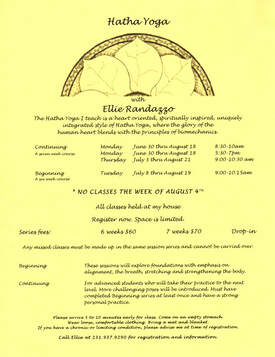 The other side
The other side Here’s what I found on the “back,” which had originally been the front: A flyer for classes taught by our beloved yoga teacher Ellie, whose death two and a half years ago devastated our community. Of course I wouldn’t sacrifice that flyer to make an ordinary page, but I’d find a way to give it a special place in the journal.

A Beginner’s Guide to Junk Journaling
Junk Journal Tutorials For Beginners
What is a Junk Journal? Junk Journaling 101 for Beginners
-- Samoan proverb loosely translated as “patience is a virtue”
Friends praised my perseverance, but I sometimes wondered if they were secretly thinking, Isn’t it about time she gave up on this thing and got on with her life? Sometimes I wondered that myself.
At the same time, I kept reading about authors—many of them famous now—who traveled the same plodding path, encountering rejection after rejection until finally they hit publication pay dirt. So I waited . . . and waited . . . and kept doing everything I could to improve my odds until, miracle of miracles, I had my own book contract in hand.

And then I found out still more patience is required. My memoir, Mango Rash: Coming of Age in the Land of Frangipani and Fanta, is due out in October of this year—a wait of another nine months, made up of a multitude of mini-waits. Right now, I’m waiting for my editor’s notes so I can begin another round of revisions. Then I’ll be waiting for more editorial input on final tweaks. And so on, and so on.
In that spirit, I’ve rounded up an assortment of wisdom on the subject to share with you today.
- Saadi
- David Droga
- Lao Tzu
- John Quincy Adams
- Arnold H. Glasow
- Deontay Wilder
- Saint Francis de Sales
- Hal Borland
- May Sarton
- Augustine of Hippo
- Sharon Salzberg in “The Power of Patience,” Awakin.org, February 10, 2014
- Erik Erikson
from the heart of the woods
Available now!
Author
Nan Sanders Pokerwinski, a former journalist, writes memoir and personal essays, makes collages and likes to play outside. She lives in West Michigan with her husband, Ray.
Archives
April 2022
August 2021
July 2021
June 2021
May 2021
April 2021
January 2021
December 2020
November 2020
October 2020
September 2020
August 2020
July 2020
June 2020
May 2020
April 2020
March 2020
February 2020
January 2020
December 2019
November 2019
October 2019
September 2019
August 2019
July 2019
June 2019
May 2019
April 2019
March 2019
February 2019
January 2019
December 2018
November 2018
October 2018
September 2018
August 2018
July 2018
June 2018
May 2018
April 2018
March 2018
February 2018
January 2018
December 2017
November 2017
October 2017
September 2017
August 2017
July 2017
June 2017
May 2017
April 2017
March 2017
February 2017
January 2017
December 2016
November 2016
October 2016
September 2016
August 2016
July 2016
June 2016
May 2016
April 2016
March 2016
February 2016
Categories
All
Art
Better Living
Books
Community
Creativity
Events
Explorations
Food
Gardens
Guest Posts
Health
Inspiration
Last Wednesday Wisdom
Local Artists
Mecosta County
Montcalm County
Music
Muskegon County
Nature
Newaygo County
Oceana County
People
Photography
Pure Michigan
Reflection
Return To Paradise
Samoa
Writing












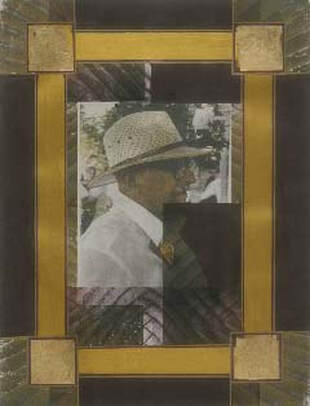

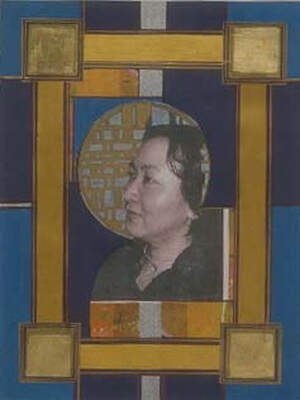




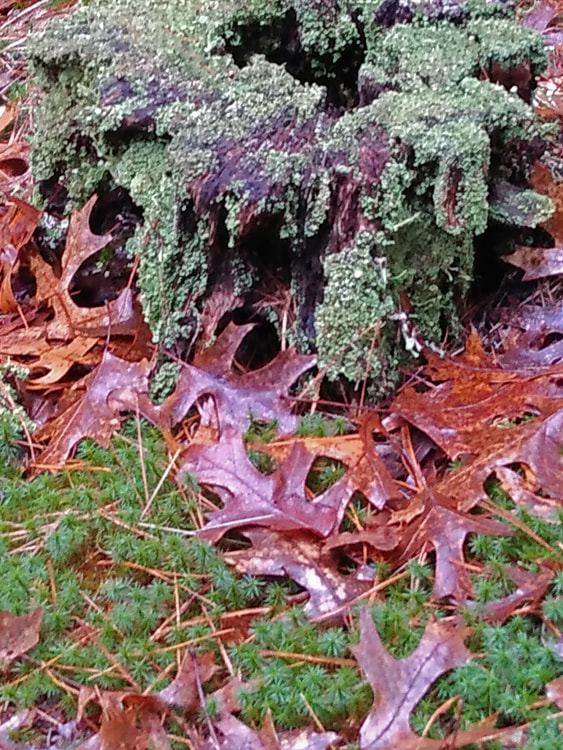

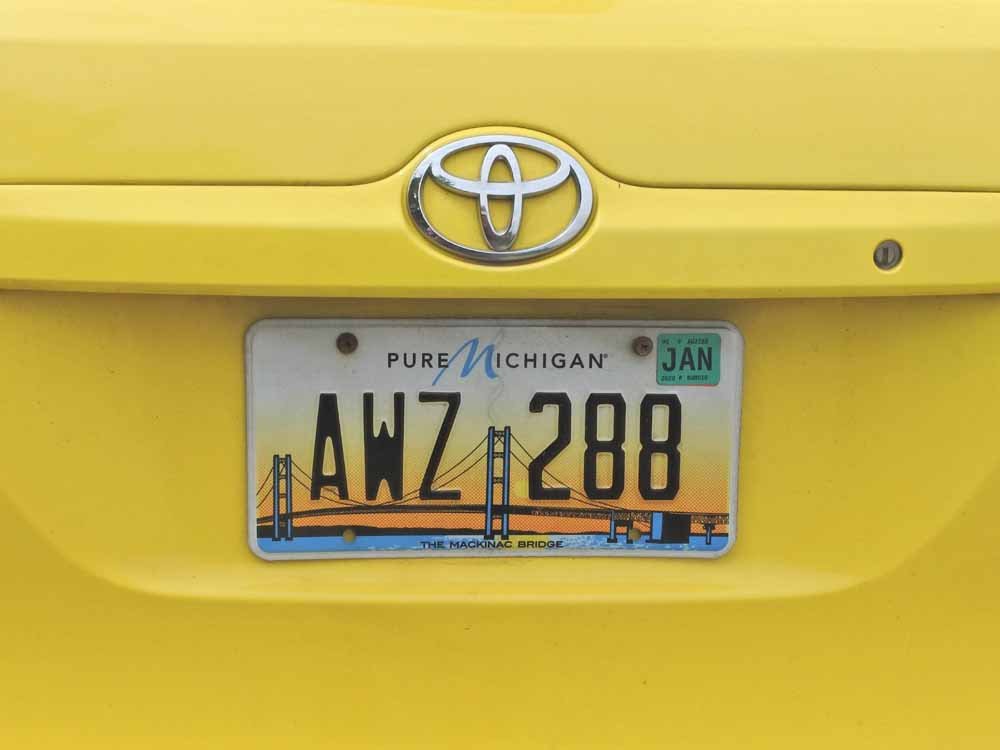




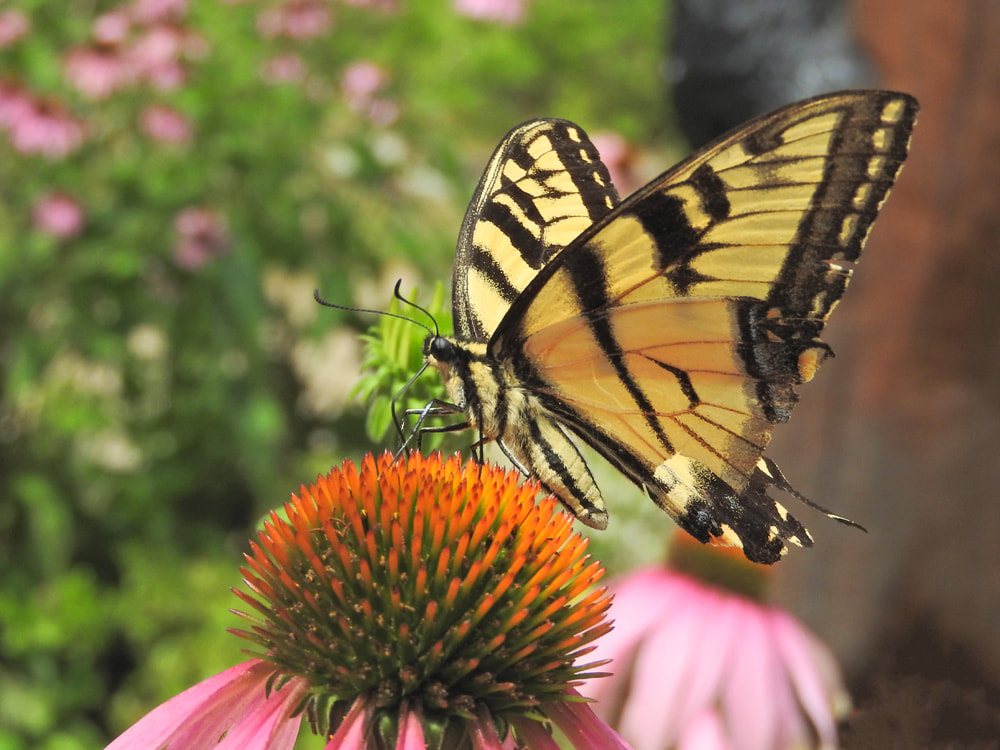






































 RSS Feed
RSS Feed